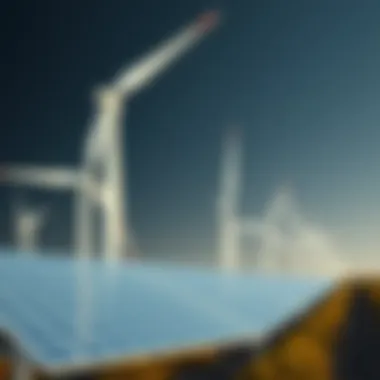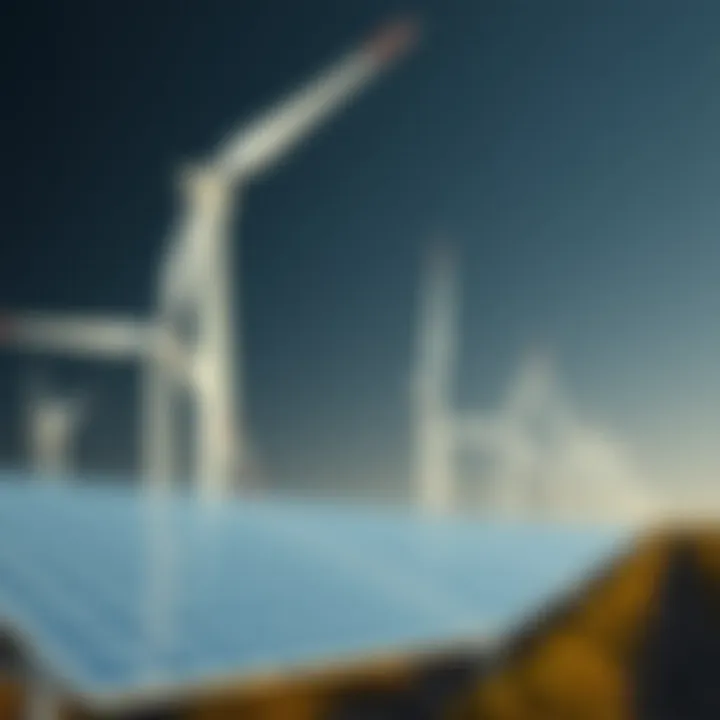Examining Vineyard Wind Stock in Renewable Energy


Intro
As the world shifts towards sustainable energy, the spotlight is on companies like Vineyard Wind. Founded to harness the potential of offshore wind energy, Vineyard Wind is at the forefront of renewable energy innovation. Investing in this stock is not just an investment in a business; it’s an investment in a future that prioritizes environmental responsibility. This article aims to peel back the layers surrounding Vineyard Wind stock. We’ll look at its market position, strategies, and the broader context of renewable energy investment. Investors need to understand the complexities and dynamics of this sector, especially in light of the rapid advancements and fluctuating market conditions.
Market Overview
Understanding the renewable energy landscape is crucial for anyone considering an investment in Vineyard Wind. The current market is characterized by a blend of opportunity and challenge, influenced by various economic and environmental factors.
Current Market Conditions
The renewable energy sector has seen a notable uptick in interest, with many stakeholders recognizing the urgency of transitioning away from fossil fuels. Government policies promoting clean energy and significant corporate investment are strengthening this shift. Nevertheless, it is a volatile market. With countries implementing their unique regulations and strategies, variations in market response are common.
Key Economic Indicators
Investors should keep an eye on key indicators that impact renewable energy stocks:
- Government Subsidies: Federal and state subsidies play a pivotal role in ensuring the viability of projects.
- Public Perception: Consumer sentiment towards renewable energy can sway market trends.
- Technological Advances: Innovations in wind turbine efficiency are crucial for long-term profitability.
Major Market Trending Factors
Several factors contribute to the trends shaping the renewable energy market:
- Political Climate: Legislative changes can greatly affect investment prospects.
- Economic Cycles: Periods of recession can slow down investment, while booms can catalyze growth.
- Global Events: The COVID-19 pandemic highlighted the fragility of energy supply chains and emphasized the need for resilience through diversification.
Stock Analysis
When evaluating any stock, a thorough analysis is imperative, and Vineyard Wind is no exception. This involves assessing both its performance and broader financial health.
Stock Performance Review
Over the past few years, Vineyard Wind stock has shown potential for growth, but it has also faced resistance. Factors like competition and public sentiment can lead to fluctuations in stock performance. Analyzing both historical data and market sentiment provides a clearer picture of its trajectory.
Fundamental Analysis (PE Ratios, Dividend Yields)
A fundamental analysis often reveals insights into a company's financial health. For Vineyard Wind, the price-to-earnings (PE) ratio can indicate how much investors are willing to pay for each dollar of earnings. Furthermore, examining dividend yields can provide insights into shareholder returns, although many growth-oriented renewable stocks may prioritize reinvestment over dividends.
Technical Analysis (Chart Patterns, Indicators)
Technical indicators play a significant role, particularly in an evolving sector like renewable energy. Chart patterns can help identify potential entry and exit points for investors. Investors often utilize moving averages and other relevant indicators to gauge momentum.
Investment Strategies
Investing is rarely a one-size-fits-all approach, and understanding different strategies can benefit those inclined to invest in Vineyard Wind.
Long-Term vs Short-Term Investing
Investors must decide whether they’re in it for the long haul or looking to make a quick buck. Long-term investing typically requires a foundational understanding of the company's potential as a sustainable player in energy, while short-term investing may focus on quick market movements.
Value vs Growth Investing
Assessing Vineyard Wind through the lens of value or growth investing can provide clarity:
- Value Investing focuses on stocks that appear to be undervalued based on fundamental analysis.
- Growth Investing prioritizes companies expected to grow at an above-average rate, even if the stock price seems high.
Risk Management Techniques
Every investment carries risk, especially in a volatile field like renewable energy. Techniques such as diversification, allocation strategies, and setting stop-loss orders can help manage risks effectively. Investors must keep these principles in mind when adding Vineyard Wind to their portfolios.
Recommended Stocks
Beyond Vineyard Wind, there are other plays in the renewable sector worth considering.
Top Stock Picks for the Month
Market conditions change rapidly, and certain stocks may stand out in any given month. Monitoring news outlets, financial websites, and environmental forums can aid in identifying top performers.
Sector-Wise Recommendations
Investors looking at diversified options might consider companies involved in solar energy, energy storage solutions, and other renewable technologies that complement Vineyard Wind.
Emerging Stocks to Watch
The renewable sector is teeming with up-and-coming companies. Keeping a close watch on startups and smaller firms focusing on niche technologies could lead to valuable investment opportunities.
Financial Education Resources
Knowledge is power. Investing in knowledge can be just as crucial as investing in stocks.
Articles and Guides for Beginners


For those new to investing, several resources are aimed at demystifying the market. Websites like Investopedia offer valuable insights.
Advanced Investment Strategies
As one’s understanding deepens, exploring advanced strategies through books and forums on sites such as Reddit can provide additional intelligence.
Tools for Financial Planning
Using budgeting tools and financial calculator apps can assist investors in making informed decisions. Websites like NerdWallet provide many resources for planning and investing in this area.
Prologue to Vineyard Wind
Vineyard Wind stands as a key player in the emerging sphere of renewable energy, particularly in the offshore wind sector. This part of the article seeks to illuminate the various aspects of Vineyard Wind that are not only significant but also foundational to understanding its broader implications in the ever-evolving renewable energy landscape. Here, we will delve into the inception of Vineyard Wind, reflecting on its roots, operational ethos, and its growth trajectory. We aim to provide investors and stakeholders with a clearer picture of what this company represents in the context of sustainability efforts and market dynamics.
The Emergence of Vineyard Wind
Vineyard Wind began its journey amidst an escalating call for cleaner energy and a shift towards renewable sources. Founded with a clear mandate to harness the power of wind along the coasts of Massachusetts, Vineyard Wind has quickly established itself as a frontrunner in offshore wind projects in the United States. The initiative symbolizes both innovation and strategic foresight in combating climate change.
This venture marks the first large-scale offshore wind project in the U.S., showcasing the potential of harnessing wind energy in a market that is still relatively nascent compared to European counterparts. The company is not just focused on generating power; it's also about creating jobs, stimulating local economies, and contributing to energy independence at a critical time for environmental sustainability.
Importantly, Vineyard Wind has secured necessary permits and governmental support, laying down a solid foundation for future developments. As government policies increasingly favor renewable resources, Vineyard Wind's early establishment in the sector provides it with a competitive edge in driving the renewable energy conversation forward.
Significance in the Renewable Energy Landscape
The significance of Vineyard Wind extends beyond its operational capabilities. In an era where energy independence and sustainability are non-negotiables, the company's efforts represent a tangible step towards a greener future. This venture has sparked interest from global investors, underscoring the reality that renewable energy is becoming not just an ethical consideration but a viable financial opportunity.
Vineyard Wind contributes crucial insights into how renewable energy investments can shape markets. The windswept waters off the coast of Massachusetts become a beacon for future investments in green technology. From policy adjustments to technological advancements, the nature of investments is changing, making understanding companies like Vineyard Wind essential for investors.
- Increased demand for clean energy
- Favorable government policies promoting renewables
- Potential for high returns through innovative technology
As a formative player in this evolving industry, Vineyard Wind's role is pivotal. With its ambitious plans, it stands not only as a symbol of progress but also as a harbinger of the trend towards sustainable investment practices. This foundation sets the stage for the subsequent examination of Vineyard Wind's stock performance and market position.
"The journey towards a sustainable future isn't just about technology, it's also about the will to transform ideas into reality."
Through this narrative, we prepare to dissect Vineyard Wind stock's implications for investors, detailing the financial metrics and competitive landscape, establishing a comprehensive view of why this venture is central to the renewable energy dialogue.
Understanding Vineyard Wind Stock
The evaluation of Vineyard Wind stock holds considerable significance in the scope of renewable energy investments. Investors, from novices just dipping their toes into the market to seasoned financial professionals, need a nuanced understanding of this stock's performance and viability. The phenomena underpinning the energy sector's shift towards sustainability have magnified the importance of evaluating individual stocks within that ecosystem.
Vineyard Wind operates within a rapidly transforming energy market. By delving into its stock performance, one can glean insights not only about the company itself but also about broader market trends. For instance, the rise of renewable investments, propelled by global climate initiatives, means that stocks like Vineyard Wind’s are not mere individual entities but part of a tapestry of energy innovation. This context is essential; investors often look to gauge not just potential returns, but also the sustainability of those returns in a market that is continually evolving.
Overview of Stock Performance
To fully grasp the current standing of Vineyard Wind, it’s critical to analyze its stock performance over recent years. The stock market segments can often resemble a roller coaster, with peaks and troughs influenced by various external factors. For Vineyard Wind, fluctuations can often be traced back to pivotal industry announcements, technological advancements, or shifts in regulatory policies.
In the last fiscal year, Vineyard Wind stock has shown signs of growth amidst a broader push for renewable energy solutions. Illustrated below are a few trends:
- Recent IPO Influence: The initial public offering created initial buzz and media attention, giving the stock a solid foundation.
- Social Sentiment: Investors’ perception, often fueled by social media, plays a role in driving up demand. Platforms like Reddit have seen discussions surrounding the stock intensify.
- Market Volatility: It’s not uncommon to see fluctuations monthly, even weekly, influenced by global events such as energy crises or climate summits.
Understanding these indicators can help potential investors decide whether to jump in or bide their time, seeing where the wind might blow next.
Key Financial Metrics
When assessing any stock, especially one in the renewable sector like Vineyard Wind, financial metrics cannot be overlooked. The numbers tell a story that goes beyond daily trades; they speak to the stability and potential of the investment.
Here are some key metrics that investors should keep an eye on:
- Revenue Growth: It’s crucial to look at the company's revenue trends to determine its growth trajectory. If Vineyard Wind consistently shows an increase in revenue, it suggests healthy demand for its services.
- Earnings Before Interest, Taxes, Depreciation, and Amortization (EBITDA): This metric offers insights into the operational profitability. A positive EBITDA indicates that the company is generating sufficient earnings from its core operations.
- Debt-to-Equity Ratio: For companies in the renewable sector, this measure helps assess financial risk. A balanced ratio can indicate a well-managed financial structure, essential for long-term sustainability.
- Price-to-Earnings (P/E) Ratio: Though it varies in significance among sectors, tracking this ratio helps in comparing Vineyard Wind against its competitors in the renewable sector.
"The viability of Vineyard Wind stock is painted by a combination of operational efficacy and market sentiment, thus requiring investors to remain vigilant on financial metrics as indicators of growth potential."
By carefully evaluating Vineyard Wind's stock through these lenses, investors can form a more rounded picture, weighing the potential risks against the anticipated rewards in this dynamic sector. Engaging in such detailed analysis positions one for more informed decision-making in a marketplace that thrives on clarity and insight.
Market Position and Competitive Analysis
Understanding Vineyard Wind's standings amid rivals in the renewable energy sector is crucial for prospective investors and industry analysts. The renewable energy market is rapidly evolving and crowded with competitors, making it imperative to gauge where Vineyard Wind fits into the larger picture. Analyzing its market position helps delineate the company’s unique selling propositions and areas of potential growth, allowing investors to make informed commitments.
Vineyard Wind's Role Among Competitors
Vineyard Wind occupies a distinct niche in the offshore wind market. As one of the pioneers in this sector, it holds several unique advantages that set it apart from its competitors:
- Geographical Advantage: Located off the coast of Massachusetts, Vineyard Wind has access to robust wind resources and proximity to emerging markets in the Northeastern United States. This prime positioning facilitates easier integration into existing energy grids.
- Early Mover Advantage: Being one of the first large-scale offshore wind projects in the U.S., Vineyard Wind can establish long-term contracts and relationships with key stakeholders before many of those who may follow.
- Innovative Technology Utilization: The company is leveraging advanced technology and best practices to ensure efficient operations and maximize energy yield. This focus on innovation may give it a competitive edge in terms of cost and output.
Despite these advantages, competition remains stiff. Companies like Ørsted and Equinor are investing heavily in the offshore wind arena, each with vast resources and extensive experience in international markets. Thus, while Vineyard Wind has carved out a promising niche, it must continually adapt and refine its strategies to maintain its lead in a dynamic and competitive landscape.
Comparative Analysis of Market Strategies
When examining Vineyard Wind's strategies against its competitors, several aspects come into play that can significantly influence investment decisions:


- Partnerships and Collaborations: Vineyard Wind's partnerships with state and local governments can amplify its credibility. Collaborations with established energy firms create synergy and enhance its operational capacity, making it a formidable contender against larger companies.
- Pricing Strategies: Competitive pricing is key in this sector. Vineyard Wind's ability to offer competitive rates while maintaining profit margins could attract more consumers and contracts, thus driving up its stock value.
- Sustainability Focus: As more investors prioritize environmental, social, and governance (ESG) factors, Vineyard Wind’s commitment to sustainable energy production positions it favorably among not only competitors but also potential stakeholders looking for responsible investment opportunities.
Investors should keep a close eye on these dynamics, as understanding Vineyard Wind's positioning and strategy compared to others can provide critical insights into its potential for growth and resilience against market inversions. To get a broader view of the competition and trends, take a look at industry analyses available at resources like Britannica or Wikipedia.
In summary, an in-depth examination of Vineyard Wind's role amidst its competitors reveals essential information about where it stands in the renewable landscape and the strategic decisions that could steer its future in the coming years.
The Regulatory Environment
The regulatory environment plays a vital role in shaping the dynamics of the renewable energy sector. Vineyard Wind, operating in a realm that is rapidly shifting due to environmental concerns and technological advancements, finds itself navigating a complex landscape of policies and regulations. Understanding this environment not only provides insights into the operational framework for Vineyard Wind but also highlights the potential investment opportunities and risks that accompany such regulations.
Understanding Policy Frameworks
At its core, the policy framework governing renewable energy encompasses a myriad of laws, agreements, and strategic initiatives aimed at promoting sustainable practices. In the United States, key legislation such as the Clean Power Plan and various state-level renewable portfolio standards sets the stage for the development of wind energy projects. These policies create a structure within which Vineyard Wind operates, dictating both the feasibility of projects and the funds available for investment.
Key elements of understanding these frameworks include:
- Federal Incentives: Programs like the Investment Tax Credit (ITC) reduce the upfront costs of renewable projects, strengthening Vineyard Wind's financial position.
- State Regulations: Different states have unique mandates that can affect project timelines and cost structures. Massachusetts, for instance, has shown significant commitment to offshore wind development, providing a more favorable environment for Vineyard Wind.
- Environmental Impact Assessments: Regulations requiring thorough environmental reviews can delay projects but are designed to ensure that developments are sustainable and responsible.
This patchwork of regulations—constantly evolving—illustrates the necessity of close attention to policy developments, as these will invariably influence Vineyard Wind's market strategy.
Impact of Regulations on Investment Opportunities
Investment opportunities within the renewable energy sector do not exist in a vacuum; they are heavily influenced by regulatory trends. For Vineyard Wind, the regulatory framework can either catalyze growth or pose significant challenges. Understanding these impacts is crucial for investors looking to gauge the company's future prospects.
- Opportunities Created by Favorable Policies
- Risks and Challenges
- Regulatory incentives can make investments in projects like Vineyard Wind more attractive. For example, enhanced federal support for offshore wind farms has led to increased investor confidence in projects that the company is undertaking.
- As states pursue aggressive emission reduction targets, companies like Vineyard Wind can benefit from guaranteed markets for their energy products.
- Conversely, ever-changing regulations present risks. Potential shifts in administration can lead to alterations in incentives, potentially creating uncertainty around long-term investments.
- Local opposition to projects, often influenced by regulatory processes, can lead to delays and increased costs for Vineyard Wind.
It’s critical for investors to be aware not only of current regulations but also of upcoming changes that may affect Vineyard Wind's operational landscape. Following relevant legislative updates will be key to making informed investment decisions.
For more information on the regulatory frameworks applicable to renewable energy, you may refer to resources like Energy.gov and EIA.gov.
Technological Advancements and Their Impact
The role of technology in the renewable energy sector cannot be overstated. It’s as if we are standing on the brink of a new era, where innovation not only fosters growth but shapes the very frameworks of how energy is sourced and consumed. In the case of Vineyard Wind, understanding the impact of technological advancements becomes paramount. The company stands at the forefront of offshore wind energy, a sector that is rapidly evolving with new technologies that enhance efficiency, reduce costs, and increase investor confidence.
As Vineyard Wind embarks on its journey, it's essential to highlight specific advancements in areas such as turbine design, energy storage solutions, and grid integration. These innovations do not merely represent incremental improvements; they signify a paradigm shift, all driven by the urgent need for cleaner energy and sustainability. Companies that adapt to these advancements will likely position themselves favorably against competitors, further elevating their stock value.
Emerging Technologies in Renewable Energy
In recent years, emerging technologies have become the cornerstone of growth and innovation in renewable energy. A few noteworthy trends include:
- Floating Wind Turbines: Unlike traditional turbines fixed on the seabed, floating turbines can be positioned in deeper waters, capturing more consistent wind currents and expanding operational areas.
- Advanced Energy Storage Systems: Breakthroughs in battery technology, like solid-state batteries, are proving crucial for storing energy generated during peak production times. This allows energy to be utilized more effectively, ensuring a stable supply.
- Smart Grid Technologies: Enhanced grid management systems and AI-driven analytics are transforming how energy distribution is managed. These systems facilitate real-time responses to energy demand, optimizing efficiency.
The application of these technologies speaks volumes about Vineyard Wind's commitment to innovation. Companies that integrate these advancements into their operations not only stand to gain market share but also attract forward-thinking investors wary of falling behind in an incredibly competitive landscape. For example, advancements in data analytics allow Vineyard Wind to monitor and forecast production with a degree of precision that was previously unthinkable.
Vineyard Wind's Technological Edge
Vineyard Wind doesn't just follow trends; it actively shapes them. The company boasts significant technological advantages that set it apart from others within the sector. One major edge comes from its strategic partnerships with technology leaders, which facilitate access to cutting-edge innovations, ensuring Vineyard Wind remains ahead of the curve. Also:
- Investment in R&D: The company's substantial investment in research and development fosters a culture of innovation, allowing it to experiment with and implement the latest technologies efficiently.
- Collaborative Development Projects: By collaborating with academic institutions and industry experts, Vineyard Wind enhances its technological capabilities. This outside-the-box thinking often leads to breakthroughs that bolster efficiency and sustainability.
"Renewable technologies are not just about energy; they are about rethinking how we approach resources and sustainability."
Project Developments and Future Prospects
The area of project developments and future prospects is fundamental for understanding both Vineyard Wind and the renewable energy sector as a whole. Significantly, it provides a lens through which investors can gauge the maturity and viability of the company's strategies. In a rapidly changing energy landscape, staying abreast of current advancements and understanding future trajectories allows stakeholders to make informed decisions.
Current Projects and Timelines
Vineyard Wind is engaged in various ambitious projects aimed at bolstering its position within the renewable market. The centerpiece is its Vineyard Wind 1 project, which has set the stage for sizable offshore wind energy input. It is recognized as the first commercial-scale offshore wind project in the United States. This project alone is anticipated to generate approximately 800 megawatts of electricity, enough to power over 400,000 homes.
- Timeline Highlights:
- 2020: Vineyard Wind received approvals, paving the way for construction.
- 2021: Commencement of installation, with significant progress reported.
- 2023-2024: Expected operational launch, contingent on regulatory and environmental compliance.
The company is not just stopping at Vineyard Wind 1. They are already laying plans for Vineyard Wind 2, which aims to expand capacity further. This proactive approach reveals the company's long-term vision and commitment. Their progress can often be tracked through various platforms, including US Department of Energy and renewable energy news outlets.
Expected Growth and Market Expansion
The trajectory of Vineyard Wind stock is inextricably linked to the company’s expected growth and the broader market trends around renewables. With a surging global demand for clean energy solutions, Vineyard Wind is poised to benefit significantly in the upcoming years. Recent analyses point to a compound annual growth rate (CAGR) of around 10% in the renewable energy sector.
- Key Factors Influencing Growth:
- Technological Innovations: Advances in wind turbine efficiency and energy storage systems are likely to make operations more cost-effective and increase output.
- Policy Support: Government incentives and regulations are expected to generate a favorable investment environment.
- Public Awareness: With climate change awareness on the rise, an increasing number of consumers are supportive of renewable energy initiatives.
Overall, Vineyard Wind’s direct alignment with these trends puts it in an advantageous position for market expansion. By keeping an eye on upcoming projects and growth forecasts, investors are encouraged to analyze how these developments could shape the financial landscape of Vineyard Wind stock in the near future.


Investment Risks and Considerations
Investing in Vineyard Wind stock presents numerous opportunities but equally comes with its fair share of risks. In the renewable energy sphere, where innovation is swift and market dynamics can change overnight, investors must tread cautiously. Understanding investment risks and considerations is crucial for anyone looking to make informed decisions in this market. The significance of identifying these risks stems from the volatility associated with renewable energy investments, as factors such as regulatory changes, technological advancements, and market competition can all influence stock performance.
As you're sizing up Vineyard Wind, it’s prudent to recognize these potential risks early on. The company's ambitious projects and innovative approach to wind energy can be lauded, yet the inherent uncertainties pose challenges. Investors must take these risks seriously, weighing the potential rewards against the hurdles that lie ahead.
Identifying Potential Risks
- Regulatory Factors
The renewable energy sector is subject to a complex web of regulations that can shift based on governmental policy. Changes in support for wind energy can impact Vineyard Wind’s projections and profitability. - Market Competition
With numerous players aiming for a share in renewable energy, competition can be cutthroat. Emerging companies could undermine Vineyard Wind’s market position, making it essential to keep an eye on competitors. - Technological Reliability
Advancements in technology can bring about efficiencies but may also render existing technologies obsolete. Vineyard Wind must stay ahead of the curve to avoid falling behind. - Economic Fluctuations
Broader economic trends can directly impact investment in renewable energy. For example, inflation could strain budgets for large-scale projects, affecting Vineyard Wind's ability to secure funding. - Public Sentiment
The public perception of renewable projects can sway government policy and investor sentiment. Negative public opinion due to environmental concerns or local disruptions can delay projects or raise costs.
Understand that while these risks are part of the landscape, having a clear view of them allows investors to better navigate the investment waters.
Mitigating Investment Risks
Mitigating risks doesn’t mean avoiding them altogether; rather, it's about taking proactive measures to lessen their impact. Here’s how investors can approach risk management with Vineyard Wind.
- Diversification
Don’t put all your eggs in one basket. By diversifying investments across different sectors within renewable energy, you can dilute the impact of a poor-performing asset. - Stay Informed
Knowledge is power. Keeping abreast of regulatory changes, market trends, and technological developments will enable you to make timely decisions about your investments. - Engage with Experts
Consulting with financial analysts and industry experts can provide you with deeper insights that might not be apparent at first glance. Their experience can help highlight hidden risks and opportunities. - Follow Financial Health
Regularly assess Vineyard Wind’s financial metrics. A sound financial condition can indicate resilience against market fluctuations. - Understand the Community
Being in tune with public sentiment and community opinions regarding wind projects can help anticipate any issues that might arise. Engaging with community feedback can lead to better project outcomes.
By identifying and proactively addressing these risks, investors interested in Vineyard Wind stock can navigate the uncertain terrain of renewable energy investments with more confidence.
Market Trends Influencing Vineyard Wind Stock
Understanding market trends that impact Vineyard Wind stock is crucial for investors navigating the fast-evolving renewable energy sector. Several factors contribute to the performance of this stock, including broader global trends, local economic conditions, and changing consumer sentiments towards sustainable energy sources. Keeping an eye on these trends equips investors with the knowledge to make strategic decisions and manage their portfolios effectively.
Global Trends in Renewable Investment
Recently, the renewable energy push has gained momentum globally, as countries shift away from fossil fuels driven by climate change concerns and regulatory pressures. Consequently, investors are increasingly looking to put their funds into green initiatives. Reports from organizations like the International Renewable Energy Agency (IRENA) reveal that in 2022 alone, global investments in renewable energy reached unprecedented levels. This surge signals not only a desire for sustainability but also growing confidence in the financial returns these investments can yield.
- Ease of access: As mechanisms for renewable projects get streamlined, companies like Vineyard Wind benefit by entering the market with reduced barriers.
- Values-driven consumerism: More investors are influenced by their ethical beliefs, driving demand for green energy integration. Stocks in this space could potentially reward investors looking for both profits and to align with their values.
- Technological Innovation: Breakthroughs in solar, wind, and energy storage technologies continually reshape investment landscapes, giving Vineyard Wind a ripe opportunity to capitalize on advancements and expand its portfolio.
In light of these global trends, Vineyard Wind's positioning within the renewable market presents compelling prospects. Investors are encouraged to consider how these overarching movements might impact stock price fluctuations and general market sentiment.
Local Economic Factors Affecting Stock Performance
On the flip side, local economic factors also play an essential role in determining how vineyard wind stock performs. Regional economic health, state policies, and community support are directly tied to how well projects succeed—both operationally and financially.
- State Regulations: For instance, if a state announces incentives for renewable energy, it could lift Vineyard Wind's stock by improving profit margins or facilitating expansion plans.
- Job Creation: Positive economic performance often translates to job creation, which in turn boosts public support for projects like Vineyard Wind, leading to favorable conditions for investment growth.
- Community Engagement: Local support can significantly buffer against potential pushback. When Vineyard Wind engages communities effectively, investors can find stability in those investments as opposed to regions facing public resistance.
As local economic factors come into play, a clear understanding of their implications for Vineyard Wind stock is vital. Investors must keep a keen ear to the ground, paying attention to regional developments that affect operational viability, public sentiment, and ultimately, stock performance.
Ultimately, combining insights from global trends with local economic realities provides a robust framework for understanding Vineyard Wind stock dynamics.
Investor Sentiment and Market Perception
Investor sentiment and market perception play a critical role in shaping the trajectory of Vineyard Wind stock within the renewable energy investment landscape. Understanding these elements helps investors gauge potential market movements, making it essential to dissect how the public’s feelings about the stock can impact its value. In turn, this awareness can influence investment decisions significantly, particularly for individual investors, financial professionals, and students keen on this bustling sector.
When it comes to investing, the mood of investors can swing like a pendulum. Positive sentiment may lead to bullish market trends, whereas pessimism can create a biting chill. Factors influencing these sentiments range from economic indicators and environmental policies to broader social attitudes toward renewable energy. Also, with the growing focus on sustainability and climate change, sentiments can tilt towards favoring companies championing these causes.
Nonetheless, recognizing the underlying factors affecting sentiment is crucial. This includes:
- Macroeconomic Trends - Economic stability or volatility can influence how investors perceive the viability of stocks in emerging industries like renewable energy.
- Technological Developments - Innovations in renewable technology can boost confidence and attract additional investments, positively swaying market sentiment.
- Regulatory Changes - New policies favoring renewable energy can enhance investor interest, signifying a healthier framework for support.
Analyzing Investor Sentiment
Analyzing investor sentiment involves not just observing stock price patterns but also understanding the emotional and psychological factors driving those trends. For Vineyard Wind, this entails a close look at how its stock fares against public perception amidst its operational realities. Here are several tools and methods used in sentiment analysis:
- Social Media Monitoring - Platforms like Facebook and Reddit can provide a pulse on public sentiment. Discussions about Vineayrd Wind on forums may reflect investor optimism or concerns.
- Survey Data - Conducting or reviewing surveys related to investor outlook on renewables can yield valuable insights. Understanding how sentiments correlate with stock decisions could shed light on future performance.
- Market Analytics - Utilizing analytics tools to assess trading volumes and price fluctuations can illustrate how sentiment affects stock trajectories. A spike in volumes might indicate a surge in interest or fear, influencing trading behavior.
By digesting these insights, stakeholders can gain a nuanced view of how investor sentiment around Vineyard Wind stock evolves over time, shaping their investment choices accordingly.
The Role of Media in Shaping Perceptions
Media plays a significant role in molding investor perceptions, acting as a bridge between companies like Vineyard Wind and potential investors. News articles, blogs, and financial reports can amplify or dampen interest in a stock, helping to create an informed investment atmosphere. For instance:
- News Coverage - Positive press releases about project milestones or technological achievements can enhance confidence in stock stability.
- Criticism and Challenges - Conversely, negative media narratives concerning project delays or regulatory hurdles can provoke skepticism, impacting stock performance.
A focused media strategy can yield benefits that extend beyond department borders. When the company communicates effectively, it helps all subsets of investors understand strategic goals, operational success, and future outlooks. Understanding how media shapes investor sentiment creates an opportunity for Vineyard Wind to leverage this dynamic.
In summary, investor sentiment and media discourse are interlinked elements that can significantly influence the performance of Vineyard Wind stock. By grasping these relationships, investors position themselves not only as participants in data analysis but as strategic decision-makers in a complex marketplace.
Culmination: The Future of Vineyard Wind Stock
The journey of Vineyard Wind within the renewable energy sector reveals much about not just the company itself, but the entire industry surrounding it. Understanding the future of Vineyard Wind stock is paramount for anyone considering an investment. The renewable energy landscape is changing at a breakneck pace, and companies like Vineyard Wind are at the forefront of this transformation. By getting a grasp on the factors affecting the stock's trajectory, investors can align their portfolios with long-term sustainability goals while still maintaining a keen eye on financial returns.
Summary of Key Insights
As previously discussed, several critical factors influence the future of Vineyard Wind stock. Here’s a quick rundown:
- Regulatory Environment: The regulatory framework plays a vital role in shaping the operational scope and profitability of Vineyard Wind. Any shifts in government policies can lead to significant implications for stock performance.
- Technological Advancements: The company’s ongoing investment in innovative technologies is a double-edged sword. On one hand, it positions Vineyard Wind as a leader; on the other, rapid tech shifts could pose risks if not managed well.
- Market Dynamics: How Vineyard Wind navigates its competitive environment will heavily influence its market valuation. Understanding the company's strategic positioning relative to its rivals offers insight into potential stock growth.
- Investor Sentiment: The amount of chatter surrounding Vineyard Wind, particularly in online investment forums or social media, can shape perceptions and ultimately affect stock price fluctuations.
In light of these factors, it's clear that Vineyard Wind brings both promise and uncertainty to the table. Investors must stay vigilant and informed.
Final Thoughts on Investment Potential
Investing in Vineyard Wind stock offers a tantalizing mix of sustainability and opportunity. The potential for growth is substantial if one can overlook the bumps in the road that come with emerging technologies and fluctuating regulatory policies. Investors should weigh the likely benefits against the natural risks of investing in a rapidly evolving sector.
- With global trends increasingly favoring renewable energy, Vineyard Wind stands to gain significant ground if it executes effectively.
- However, it is crucial for investors to not only look at the bright prospects but also understand the volatility and potential risks associated with such investments. The more informed investors are about these dynamics, the better decisions they can make.





